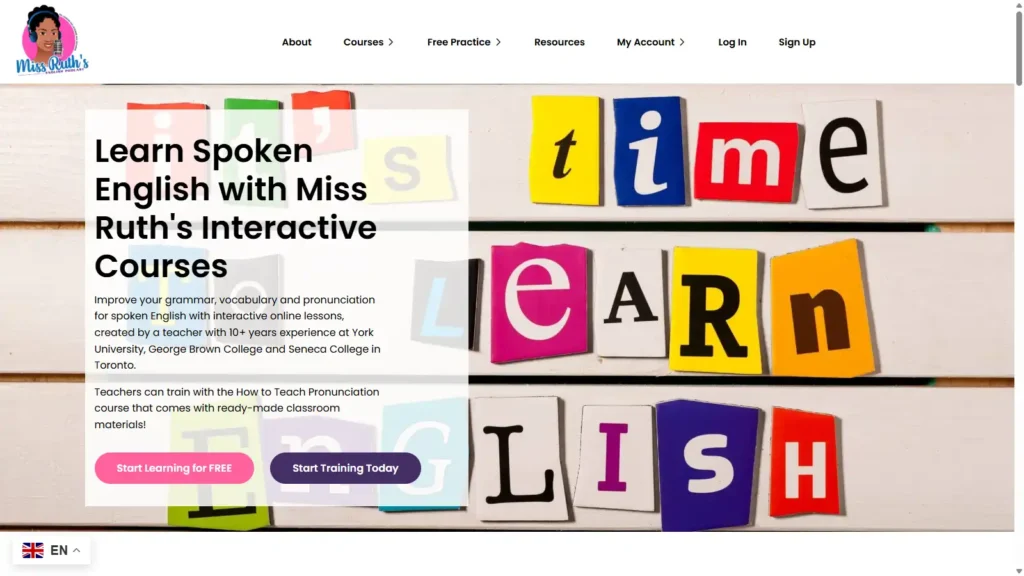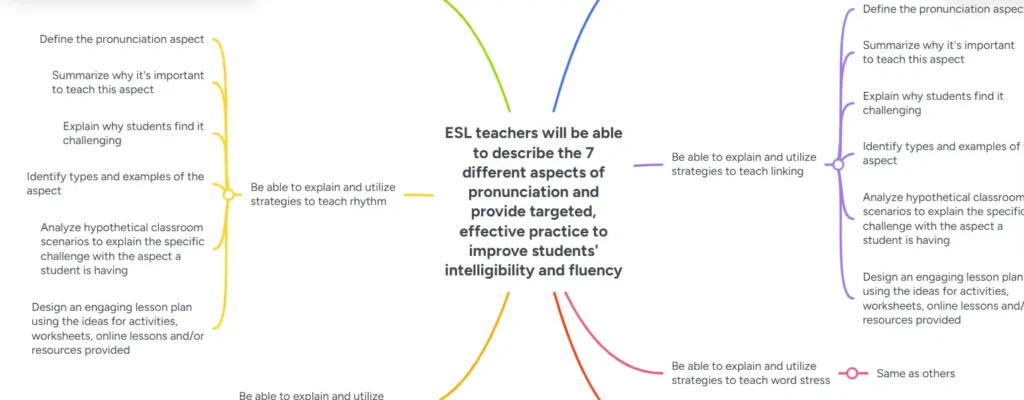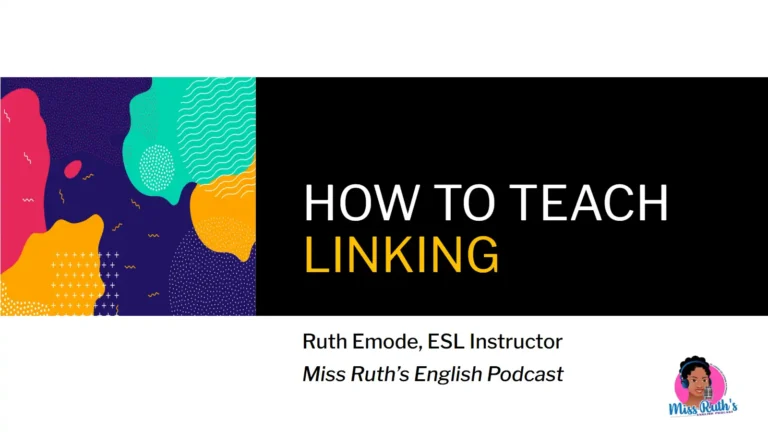Online Training for Teaching Pronunciation
I designed and develop elearning, “How to Teach Pronunciation for Spoken English,” with interactive videos, downloadable worksheets, and virtual activities for teachers to learn the 7 aspects of pronunciation and how to create engaging, effective lesson plans for their students. Discover the project below.

Overview
Audience
English as a Second Language (ESL) teachers who want to teach their students pronunciation of North American English speech, as opposed to written English
Responsibilities
Instructional Design, eLearning Development, Web Design, Branding & Visual Design, Audio & Video Scripting, Recording & Editing, Marketing
Tools
WordPress, Elementor, Gutenberg Block Editor, Paid Membership Pro, LearnPress, H5P, Bandlab, Spotify for Podcasters, ClipChamp, Canva, Miro, Zoom, High Level CRM, Google Translate, Google Search Console, Matomo and Google Analytics, Mailchimp, MindMeister
Analysis
The vast majority of TESL programs do not provide their students with any training in teaching pronunciation. When pronunciation is included among other speaking skills, it is often reduced to drill practice of similar sounds—also known as minimal pairs—such as the vowel sounds in “sheep” vs. “ship.” Few resources offer a holistic method of integrating pronunciation instruction into reading, listening, and grammar lessons.
One of the major shortcomings of English for Academic Purposes (EAP) programs is their heavy focus on reading, writing, and grammar, which often leads to students completing all nine levels with little improvement in their ability to speak and be understood.
Improving pronunciation is essential to helping ESL learners become more comprehensible to others. Without dedicated time spent on this specific subset of oral skills, students in ESL courses miss crucial opportunities to enhance their communication abilities in a more comprehensive way—one that addresses various aspects of human speech beyond just vowel and consonant sounds.
Through informal survey discussions with colleagues at York University and George Brown College, I confirmed a widespread knowledge and skills gap in teaching pronunciation—except among those who had earned a Master’s in Linguistics.
Although I had presented at conferences and facilitated workshops on this topic, I decided to develop an online course to reach TESL students and current teachers worldwide who needed a flexible learning experience to fit additional professional development into their schedules. This aligns some components of the RIPPLES framework, which ask instructional designers to consider Resources, Infrastructure, People, Policies, Learning, Evaluation, Support when analyzing factors.
I conducted research to find academic resources on teaching English as a second language that faculty without postgraduate training in linguistics could easily comprehend.
While I found numerous online references, one book—Teaching Pronunciation: A Course Book and Reference Guide by Marianne Celce-Murcia and others—was instrumental in expanding my own repertoire of pronunciation teaching strategies and in shaping my curriculum objectives.
To make pronunciation more accessible, I simplified its various components into seven categories that could be easily understood by those new to the field.
Action Mapping
Using Bloom’s Taxonomy, I created an action map outlining the observable, measurable tasks educators need to complete in order to learn and teach pronunciation effectively.
Notably, before developing the teacher training, I had already created a series of beginner and intermediate student courses featuring interactive activities based on the seven areas of pronunciation, integrated with listening and speaking practice.
Design
PowerPoints
I created seven PowerPoint presentations, each focused on a different aspect of pronunciation. Each presentation explains why teachers should address that specific element with ESL students, how it can enhance fluency and clarity of speech, and how this, in turn, increases motivation to teach it. I shared these materials with fellow teachers, who responded enthusiastically to having more resources for teaching pronunciation.
Assessments
In addition, the presentations explore common challenges students face when mastering each area, illustrate different types with clear examples, and offer classroom activity ideas. For summative assessment, I developed questions to check teachers’ understanding of the concepts, including scenario-based prompts that require them to apply theory to realistic classroom situations.
Worksheets
To make it easier for educators to incorporate pronunciation instruction into their already full syllabi, I also created worksheets and online activities for each aspect that can be used immediately. I included a lesson planning section where teachers can integrate ideas from the presentations.
Gagne's Nine Events
I also included a curated list of online resources for further professional development or classroom use. By incorporating these components, the course design aligns with Gagné’s Nine Events of Instruction.
Finishing Up
That is to say, the course gains attention with an introductory video explaining the relevance and learning objectives, presents content with practice opportunities and feedback, and encourages the creation of lesson plans for immediate application.
Sample PowerPoint
Click here or on the image to open the entire presentation used to make the training on linking
Development
Process
I recorded seven videos—one for each pronunciation skill—and used H5P, a popular educational technology tool, to make them interactive by adding questions after each section.
You can explore their website to see the wide range of possible interactions, from simple multiple-choice questions to hotspots, drag-and-drop activities, branching scenarios, and interactive books.
In line with Mayer’s Pre-Training Principle of Multimedia Learning, I created an introductory video to explain how to use all the available tools and materials.
Miss Ruth’s English Podcast is built on WordPress, the world’s most popular content management system (CMS). I use LearnPress—a WordPress plugin for creating online courses—which supports the integration of H5P interactives directly into lesson content.
After creating each H5P component, I embedded them into a LearnPress course on my website, just as I had done with the 19 student courses I previously developed.
I also used H5P to create a lesson plan template that allows users to fill out each section and export it as a document, ready for classroom use.
Features
Simplification of Complex Linguistic Topics
Interactive Videos
Mini-Course on How to Rap
This course is based on classes I taught at York University, where students and I produced amateur music videos to document their improved pronunciation and increased confidence in speaking. The mini-course is a strong example of scaffolding in action: it guides learners step by step through essential elements—starting with flowcharts, types of rhyme, and figures of speech—before challenging them to apply what they’ve learned in a complete song.
Other H5P Interactive Activities in the Beginner & Intermediate Courses
You can explore the Beginner English 1 course to see how I’ve incorporated various H5P interactives to support ESL instruction.
Mobile-Responsive Design
Universal Design for Learning (UDL) Principles: Multiple Means of Representation, Action, and Expression
The course’s audio and video content includes captions, transcripts, or both. Learners can also stream podcast episodes directly on Spotify. For audio content, playback speed controls are provided so users can listen at a slower pace if needed.
All ESL courses for students begin by activating prior knowledge through questionnaires. With the inclusion of multimedia, the lessons support multiple forms of expression: learners are asked to listen, take notes, speak into the microphone, practice with visuals, and even learn through music with the rap mini-course.
To increase accessibility, I also added a translation tool so ESL students who find the material challenging can switch between English and their first language to improve comprehension.
Implementation & Evaluation
In line with the Kirkpatrick Model of Evaluation, I gathered informal feedback by observing initial reactions from teachers and students, analyzing data from the WordPress LMS, and collecting evidence of pronunciation learning in the classroom.
The response from my colleagues was enthusiastic. A few teachers across Canada have subscribed to the website, watching videos and using the worksheets. Students have benefited from learning pronunciation in manageable chunks through scaffolded activities that progressively guide them from the easiest to the most challenging skills.
Using LearnPress analytics, I can track which lessons learners have started, how many they have completed and when, and whether they achieved the passing score of 50% on the H5P interactive activities.
This provided concrete evidence of learning, including feedback from and marks given to my own students, who discovered helpful new information about English—for example, words with disappearing syllables, such as how “chocolate” is pronounced differently from how it is written—and new YouTube channels and online resources they appreciated.
Testimonials
EAP Professor & Trained Instructional Designer
ESL Instructor & Learning Experience Designer
Former Student, Chinese Speaker
Results & Takeaways
Web Redesign
Downloadable Worksheets
Based on feedback from teachers, I made the worksheets downloadable. In agreement with Mayer’s Segmenting Principle of Multimedia Learning, I also separated the 7 different H5P interactive activities for each aspect of pronunciation into different pages to make the course less intimidating.
Finally, I provided clearer directions on how their students could gain access the materials.
Summary
Overall, the materials were well received—teachers praised the comprehensiveness of the content, and students found the beginner and intermediate lessons engaging.


